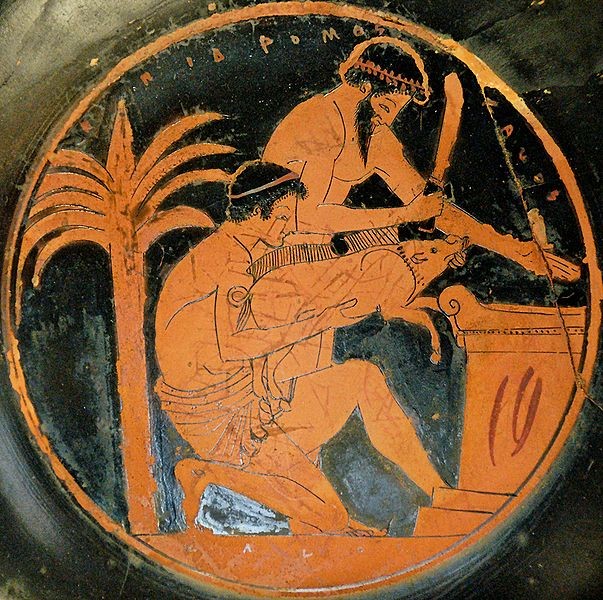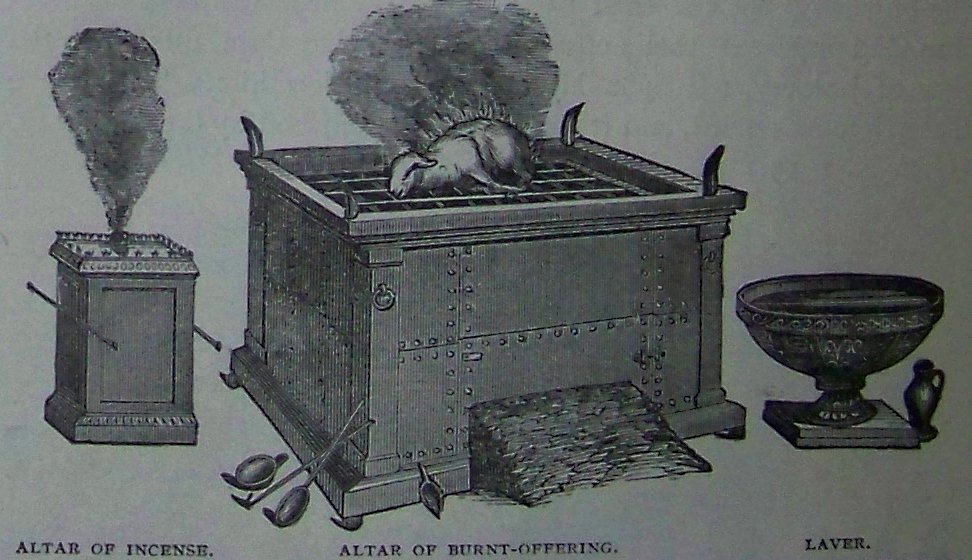Burnt offering on:
[Wikipedia]
[Google]
[Amazon]
A holocaust is a religious
 ''Holokautein'' (ὁλοκαυτεῖν) is one of the two chief verbs of Greek sacrifice, in which the victim is utterly destroyed and burnt up, as opposed to ''thúesthai'' (θύεσθαι), to share a meal with the god and one's fellow worshippers, ''commensal'' sacrifice. In the latter, the edible parts of the sacrificed animal were roasted and distributed for festive celebration, whereas the inedible parts were burned on the
''Holokautein'' (ὁλοκαυτεῖν) is one of the two chief verbs of Greek sacrifice, in which the victim is utterly destroyed and burnt up, as opposed to ''thúesthai'' (θύεσθαι), to share a meal with the god and one's fellow worshippers, ''commensal'' sacrifice. In the latter, the edible parts of the sacrificed animal were roasted and distributed for festive celebration, whereas the inedible parts were burned on the
 A "burnt offering" is a type of
A "burnt offering" is a type of
animal sacrifice
Animal sacrifice is the ritual killing and offering of animals, usually as part of a religious ritual or to appease or maintain favour with a deity. Animal sacrifices were common throughout Europe and the Ancient Near East until the spread of Chris ...
that is completely consumed by fire, also known as a burnt offering. The word derives from the ancient Greek
Ancient Greek (, ; ) includes the forms of the Greek language used in ancient Greece and the classical antiquity, ancient world from around 1500 BC to 300 BC. It is often roughly divided into the following periods: Mycenaean Greek (), Greek ...
''holokaustos'', the form of sacrifice in which the victim was reduced to ash, as distinguished from an animal sacrifice that resulted in a communal meal.
Etymology and usage
The word ''holocaust'' derives from the Middle English ''holocaust'', which derived from the Anglo-Norman ''holocauste'' and Late Latin ''holocaustum''. Its original root was the neuter form of theancient Greek
Ancient Greek (, ; ) includes the forms of the Greek language used in ancient Greece and the classical antiquity, ancient world from around 1500 BC to 300 BC. It is often roughly divided into the following periods: Mycenaean Greek (), Greek ...
''holokaustos'' (ὁλόκαυστος), from ὅλος (hólos, “whole”) + καυστός (kaustós, "burnt") or καίω (kaíō, "I burn") with the use of rough breathing
In the polytonic orthography of Ancient Greek, the rough breathing ( or ; ) character is a diacritical mark used to indicate the presence of an sound before a vowel, diphthong, or after rho. It remained in the polytonic orthography even af ...
to pronounce the leading h.
Greek sacrifice
 ''Holokautein'' (ὁλοκαυτεῖν) is one of the two chief verbs of Greek sacrifice, in which the victim is utterly destroyed and burnt up, as opposed to ''thúesthai'' (θύεσθαι), to share a meal with the god and one's fellow worshippers, ''commensal'' sacrifice. In the latter, the edible parts of the sacrificed animal were roasted and distributed for festive celebration, whereas the inedible parts were burned on the
''Holokautein'' (ὁλοκαυτεῖν) is one of the two chief verbs of Greek sacrifice, in which the victim is utterly destroyed and burnt up, as opposed to ''thúesthai'' (θύεσθαι), to share a meal with the god and one's fellow worshippers, ''commensal'' sacrifice. In the latter, the edible parts of the sacrificed animal were roasted and distributed for festive celebration, whereas the inedible parts were burned on the altar
An altar is a table or platform for the presentation of religion, religious offerings, for sacrifices, or for other ritualistic purposes. Altars are found at shrines, temples, Church (building), churches, and other places of worship. They are use ...
, those being the god's share. Although not actually ''obliged'' to do so, Greeks would rather sacrifice a domestic animal to a god or hero and then proceed to use its flesh as food than simply consume it without a sacrifice, as animals were thought of as sharing in the sanctity of life, in addition to their secular usefulness (milk, eggs, ploughing). This did not apply to game, fish, and other seafood, which formed a far larger proportion of the diet than they do today – fish was the major foodstuff sold in ancient Greek marketplaces. A sacrifice need not be a public function involving priests and altars; they could also be held privately, domestically or individually.
These are the two ideal types of Greek sacrificial ritual; they are appropriate to different divinities, done for different purposes, and conducted by different methods. Holocausts are apotropaic rituals, intended to appease the spirits of the Underworld, including the Greek heroes, who are spirits of the dead; they are also given to dangerous powers, such as the Keres and Hecate
Hecate ( ; ) is a goddess in ancient Greek religion and mythology, most often shown holding a pair of torches, a key, or snakes, or accompanied by dogs, and in later periods depicted as three-formed or triple-bodied. She is variously associat ...
. One of the earliest attested holocausts was Xenophon
Xenophon of Athens (; ; 355/354 BC) was a Greek military leader, philosopher, and historian. At the age of 30, he was elected as one of the leaders of the retreating Ancient Greek mercenaries, Greek mercenaries, the Ten Thousand, who had been ...
's offering of pigs to Zeus Meilichius.
Holocausts are conducted at night, without wine, and offer black-hided animals at a low altar, with their heads directed downwards; in all these they are opposed to the commensal sacrifice given to the Olympian gods. (This distinction is between extreme types, and was somewhat exaggerated in the early twentieth century, as by Jane Harrison; considerable evidence has also been found of commensal sacrifice offered to heroes.)
Jewish sacrifice
 A "burnt offering" is a type of
A "burnt offering" is a type of korban
In Judaism, the (), also spelled or , is any of a variety of sacrificial offerings described and commanded in the Torah. The plural form is , , or .
The term primarily refers to sacrificial offerings given from humans to God for the pur ...
(sacrifice), specifically an animal sacrifice
Animal sacrifice is the ritual killing and offering of animals, usually as part of a religious ritual or to appease or maintain favour with a deity. Animal sacrifices were common throughout Europe and the Ancient Near East until the spread of Chris ...
in which the entire sacrifice is consumed totally by fire. When the Jewish scriptures were translated into the Koine Greek
Koine Greek (, ), also variously known as Hellenistic Greek, common Attic, the Alexandrian dialect, Biblical Greek, Septuagint Greek or New Testament Greek, was the koiné language, common supra-regional form of Greek language, Greek spoken and ...
Septuagint
The Septuagint ( ), sometimes referred to as the Greek Old Testament or The Translation of the Seventy (), and abbreviated as LXX, is the earliest extant Greek translation of the Hebrew Bible from the original Biblical Hebrew. The full Greek ...
, the translators used the Greek term ''holokautein'' to translate the Hebrew ''olah''. This form of sacrifice, in which no meat was left over for anyone, was seen as the greatest form of sacrifice''Jewish Encyclopedia'' and was the form of sacrifice permitted to be given solely at the Temple by Jews
Jews (, , ), or the Jewish people, are an ethnoreligious group and nation, originating from the Israelites of History of ancient Israel and Judah, ancient Israel and Judah. They also traditionally adhere to Judaism. Jewish ethnicity, rel ...
and non-Jews.
The "whole offering" is believed to have evolved as an extreme form of the slaughter offering, in which the portion allocated to the deity increased to all of it. In slaughter offerings, the portion allocated to the deity was mainly the fat
In nutrition science, nutrition, biology, and chemistry, fat usually means any ester of fatty acids, or a mixture of such chemical compound, compounds, most commonly those that occur in living beings or in food.
The term often refers specif ...
, the part which can most easily be burnt.
The animals, having first been checked to ensure they were free from disease and unblemished (a requirement of the sacrifice), were brought to the north side of the altar, and killed by either the offeror, or a priest
A priest is a religious leader authorized to perform the sacred rituals of a religion, especially as a mediatory agent between humans and one or more deity, deities. They also have the authority or power to administer religious rites; in parti ...
. The animal's blood was carefully collected by priests and sprinkled around the altar. Unless the animal was a bird, its corpse was flayed and the skin given to the priest, who was permitted to keep it. In later times more powerful priests took possession of the skins from the lesser priests, and it was decreed that the skins should be sold, with the proceeds being given to the Temple in Jerusalem
The Temple in Jerusalem, or alternatively the Holy Temple (; , ), refers to the two religious structures that served as the central places of worship for Israelites and Jews on the modern-day Temple Mount in the Old City of Jerusalem. Accord ...
(Tosefta 19). The flesh of the animal was divided according to detailed instructions given by the Talmud
The Talmud (; ) is the central text of Rabbinic Judaism and the primary source of Jewish religious law (''halakha'') and Jewish theology. Until the advent of Haskalah#Effects, modernity, in nearly all Jewish communities, the Talmud was the cen ...
(Tamid 31), and would then be placed on the wood on the altar (which was constantly alight due to the large number of sacrifices carried out daily), and slowly burnt. After the flesh (including any horns and goats' beards) had been reduced to ashes, usually the following morning, the ashes were taken by the priest to a ritually clean location outside the sanctuary, and dumped there.
Most biblical scholars now agree that the intricate details of the whole offering, particularly the types and number of animals on occasion of various feast days, given by the Torah
The Torah ( , "Instruction", "Teaching" or "Law") is the compilation of the first five books of the Hebrew Bible, namely the books of Genesis, Exodus, Leviticus, Numbers and Deuteronomy. The Torah is also known as the Pentateuch () ...
, were of a late origin, as were the intricate directions given in the Talmud. Whole offerings were quite rare in early times, but as the ritual became more fixed and statutory, and the concentration of sacrifice into a single sanctuary (particularly after Josiah
Josiah () or Yoshiyahu was the 16th king of Judah (–609 BCE). According to the Hebrew Bible, he instituted major religious reforms by removing official worship of gods other than Yahweh. Until the 1990s, the biblical description of Josiah’s ...
's reform) made sacrifices quite distinct from simply killing animals for food, whole offerings gradually rose to great prominence.
See also
* * * * * * *Notes
References
* Jane Harrison, ''Prolegomena to the study of Greek Religion'' Princeton University Press, 1991; * ''Brill's New Pauly : encyclopaedia of the ancient world'', 2002- : Vol XII, Prol-Sar, *Rebecca I. Denova, ''Greek and Roman Religions'' Newark: John Wiley & Sons, Incorporated, 2019 {{DEFAULTSORT:Holocaust (sacrifice) Fire in religion Greek animal sacrifice Jewish animal sacrifice Hecate